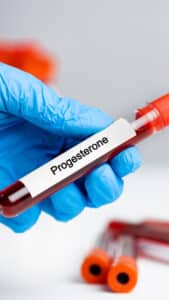
Progesterone is the Key Anti-Cancer Hormone of the Body
Progesterone increases the Tumor Suppressor Protein known as p53, the “guardian of the cell” and decreases the cancer activating protein known as bcl-2. Tumor Suppressor Protein (p53) guards against cellular mutations that can cause cancer in the following ways:
- Activation of DNA repair
- Stops Cell growth when necessary to allow DNA time to repair
- Initiates programmed cell death (apoptosis) when DNA damage is irreparable
Estradiol Promotes Cell Proliferation & Cancer
Estradiol, on the other hand, stimulates cellular proliferation and does the opposite of progesterone. Estradiol causes a decrease in p53 and increases bcl-2, the opposite acting protein that stimulates cancer cell proliferation.
Breast Cancer and Progesterone Deficiency
One of the most significant studies of the relationship between low levels of natural progesterone and increased breast cancer risk was published in the American Journal of Epidemiology in 1981. The study followed 1,083 women with a history of difficulty becoming pregnant for periods ranging from 13 to 33 years.
The researchers found that infertile women who demonstrated a progesterone deficiency had a premenopausal breast cancer risk that was 540% greater than that of women whose infertility was due to non-hormonal causes. Furthermore, the women with a progesterone deficiency had a 1,000% greater chance of death from all types of cancer.
Serum progesterone levels at the time of breast cancer surgery influence survival rates, according to a 1996 study published in the British Journal of Cancer. Women who had progesterone levels of 400 ng/dL or greater at the time of breast cancer surgery had significantly better survival rates at 18 years than those with lower serum levels of progesterone at the time of surgery. In women with higher progesterone levels at the time of surgery, approximately 65% were alive 18 years later, whereas only 35% of the women with low progesterone levels survived 18 years.
Uterine Cancer and Progesterone
Conventional estrogen replacement therapy with synthetic estrogens increases the incidence
of endometrial (uterine lining) abnormalities, including cancer, according to a study published in the Journal of Endocrinolgy, Sept 2004.
Here’s the take home message: Breast cancer cells do not multiply when women have a sufficient supply of progesterone. Progesterone likewise also prevents cancer of the ovary and uterus as well as small cell lung cancer which is normally a very difficult cancer to treat.
Progesterone in Men
Men make about half as much progesterone as women. However, it is extremely important for men as well as it is for women. Progesterone gets converted into Testosterone. Most men know that the loss of Testosterone is associated with aging and causes decreased libido and erectile dysfunction. It is also associated with prostate cancer.
Progesterone preserves natural stores of Testosterone by preventing it from being converted into Di-Hydro-Testosterone (DHT), which blocks the prostate and causes Benign Prostate Enlargement and it’s bothersome symptoms including frequent urination, hesitancy, feeble urine stream and night-time urination. Too much DHT also blocks the hair follicles and is the principal cause of male pattern baldness.
A deficiency of Testosterone, in men or women, is associated with a loss of muscle mass, joint pains, heart disease and the tendency to put on excess abdominal fat. Taking supplemental natural progesterone can boost your Testosterone level.
Progesterone and Prostate Cancer
Men typically make a very small amount of Estrogen: about 1/10th the amount of a woman. However, if the ratio of Estrogen to Progesterone gets out of balance, prostate cancer develops for the same reason breast or uterine cancer develops in a woman. Progesterone protects against cancer growth and Estradiol activates cancer cell growth.
What is the best form and dose of Progesterone?
The most effective form of progesterone is the oral, sub-lingual (under the tongue) form. The submucosal membranes under the tongue are specifically designed for direct absorption into the bloodstream. Topical skin creams are not a good choice because the skin is designed by nature to be a barrier and to block absorption. It may work ok for a short while, but eventually progesterone applied to the skin gets shunted into fat cells and begins to build up. Eventually this excess progesterone can cause swelling, moodiness and irritability and more importantly it does not get into the blood stream.
The mucous membranes of the mouth however, were designed for absorption. When progesterone is absorbed in the mouth, it is absorbed and transported through the blood stream directly to the ovaries, uterus and receptors on the pituitary gland, before it is broken down in the stomach or the liver and excreted from the body. I have found this method to be very effective without any excess buildup over time.
The sub-lingual form is safe to take for extended periods. The usual sub-lingual dose is 50 to 100 mg of natural progesterone daily depending on the individual. To determine the correct amount that is right for you, I recommend testing before and after one to three months of natural progesterone therapy. A blood test is preferred to saliva testing because sub-lingual dosing can remain in the saliva up to 48 hours after dosing and skew the results. It is recommended that you test your progesterone level every twelve months to make sure you remain at the optimal level.
Testing Your Progesterone Level
A woman should test her hormone periodically to make certain they are in balance and take a natural Progesterone supplement if her levels get too low, along with any of her other sex hormones that are out of balance. Progesterone shoud be 100x higher than Estradiol at the Mid-luteal Phase of a woman’s cycle, or day 21 of a typical 28 day cycle. For menopausal women, Progesterone should again be 100x higher than their Estraiol level.


